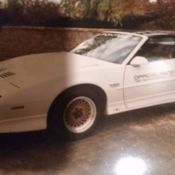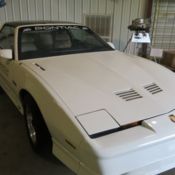Description
This a true sports and collectable PontiacTurbo Trans Am PACE CAR 20th anniversary this vehicle is number 268 out of 1500 copies ever with only 18,600 original and documented miles I am the second owner and I have all books and record this is a one of a kind vehicle. Should you have any questions feel free to email me. NO PAYPAL, O SCAMS ONLY SERIOUS BUYERS WITH CASH.To celebrate the twentieth anniversary of its muscle car, ontiac is producing a run of 1500 special Trans Ams powered by a modified version of the lusty Buick Turbo 3.8L V6. This limited production 20th Anniversary Trans Am has also been selected as the pace car for this year's Indianapolis 500.Of course, he hoopla surrounding this car would be hollow indeed if the 20th Anniversary Trans Am wouldn't outperform the old Regals. Rest assured that the turbo-T/A is equal to the accolades.....Our test car scorched the drag strip with a 0-60-mph blast of 4.6 seconds and a quarter-mile run of 13.4 seconds at 101 mph. That means, s we go to press that the turbocharged Trans Am is the quickest 0-60 sprinter available in any US production-car showroom -- at any price.Achieving such stunning times doesn't require high-rpm clutch drops or other test-track trickery. Just pop the automatic transmission into Drive, old it with the brake while you raise the engine speed to 2100 rpm, elease the brake, nd floor the throttle. The turbo Trans Am instantly shoots forward like a runaway rocket sled. The roar from the under the hood builds as the boost gauge needle dances around the 16.5-psi mark. And the Turbo Hydramatic T200R4 four-speed automatic snaps off crisply at just over 5000 rpm -- without a nanosecond of lost thrust. The rush is so strong that the turbo Trans Am reaches 130 mph in just 30.2 seconds.No such precautions are needed with the turbo Trans Am. Thanks to its performance-oriented platform, he turbo T/A can run without a speed limiter. Thus freed, he turbocharged 3.8-liter V6 is able to push the Trans Am all the way up to 153 mph. At last: straight-line performance that delivers on the promise of both the Trans Am and the Buick V6.The most significant change is a new set of cylinder heads, orrowed from the transverse-mounted version of the 3.8-liter six that GM uses in many of its front-drive cars. Pontiac adopted the new heads because they fit more easily within the narrow confines of the Trans Am's engine compartment. In addition, he new heads provide better exhaust flow and have a more efficient combustion-chamber shape than their predecessors.A new set of pistons match the cavities in the new heads to preserve the engine's 8.0:1 compression ratio. The exhaust gases are collected from each cylinder head via short-runner, qual-length headers and are fed to an AiResearch T3 turbocharger mounted in the right-front corner of the engine compartment. The turbo blows through an intercooler mounted just behind the radiator to pressurize a tuned intake system fitted with sequential fuel injection. A knock sensor reduces the chance of engine meltdown by signaling the engine-management system to retard spark advance and reduce boost pressure whenever it senses uncontrolled combustion. (To minimize these power-reducing measures, ontiac recommends premium fuel.)Pontiac's output claims for the V6 are exceedingly modest: 250 hp at 4400 rpm and 340 pound-feet of torque at 2800 rpm. Judging by our performance figures, e estimate that the engine produces closer to 300 hp.Bigger front brakes are the only other important mechanical change on the 20th Anniversary Trans Am. Beefy 11.9-inch-diameter rotors with twin-piston calipers replace the 10.5-inch rotors and single-piston calipers used on all other Firebirds. The big brakes provide the additional fade resistance needed to cope with the turbo's penchant for high speed. Unfortunately, ront-rear brake balance is poor. Out test car needed 217 feet to stop from 70 mph, argely because the rear discs locked up prematurely. Pedal feel was also disappointing.The 20th Anniversary Trans Am shares its other underpinnings with the GTA and Formula Firebirds. For the suspension, hat means struts in front, precisely located live axle in the rear, nd deflected-disc, as-filled shocks and stiff coil springs at all four corners. A 36mm anti-roll bar is used up front; a 24mm bar is fitted to the rear. Traction is provided by P245/50ZR16 Goodyear Gatorbacks on 8.0-inch-wide aluminum wheels. The only non-standard suspension parts are slightly softer front springs, hich are suitable because the blown V6 weighs about 100 pounds less than the V8 engines normally fitted to Trans Ams.The turbo T/A's suspension works superbly on smooth surfaces. The car steers precisely and adheres to the road with a vein-popping 0.88g of grip. Best of all, he T/A is wonderfully stable at the limit - although the engine's surgy power delivery can make fine adjustments difficult. There's just enough understeer to instill confidence, ut you can easily kick the tail out by flicking the wheel or stepping into the boost.Unfortunately, he turbo Trans Am loses its manners when the road gets rough. There seems to be a mismatch between the springs and the shock absorbers -- a mismatch that keeps the Trans Am from ever settling down and feeling planted. Big bumps bottom the rear suspension easily -- causing the car to bounce and lose traction when you're cornering hard.Small bumps can be almost as irritating. Tar strips and misaligned pavement slabs pound through the suspension so brutally that you'd swear the tires were made of solid rubber. Fender clearance is also on the tight side; both the front and rear tires occasionally rub against the bodywork in normal driving. All in all, he old turbocharged Regals were infinitely more comfortable for relaxed cruising.The nonabsorbent ride would be less bothersome if the anniversary Trans Am were tight and solid. But every bump summons another in a seemingly endless repertoire of creaks, roans, queaks, nd rattles. Admittedly, ur test car was at a disadvantage -- being equipped with the optional T-top removable roof panels -- but even solid-roofed Firebirds suffer from this unbuttoned feeling. All 20th Anniversary Trans Ams are being built in a special production facility, here an additional quality-control stage attempts to tighten up the car as much as possible. But there's only so much that can be done with the Firebird's basic structure.If you're beginning to get the idea that the turbo Trans Am has more in common with a 1965 GTO than with a modern sports car, ou're right. The T/As remarkable acceleration and amazing handling comes more from brute muscle and huge, ticky tires than from finesse and refined technology. The 20th Anniversary Trans Am is a muscle car from the traditional mold.Inside, he turbo T/A displays a mixture of modern and old. The basic combination of a big exterior and a small interior harks back to the inefficient days of yesteryear, hile the instrument layout, he modern seats, nd the excellent driving position seem fully up-to-date.Included as standard equipment is a set of futuristic-looking sport seats, hich offer power lumber and side-bolster adjustments -- as well as manual controls for headrest position, high supports, nd front height. Equally contemporary are the radio controls in the steering wheel hub, hich work well without interfering with your hand positions on the wheel.All 20th Anniversary Trans Ams come in white with tan interiors. Further identification is provided by "Turbo Trans Am" badges on both front fenders, ndianapolis logos on both rocker panels, loisonné "20th Anniversary Trans Am" insignias on the nose and both C-pillars, new filler panel between the taillights, nd quad tailpipes. In addition, ach car comes with a set of "Official Pace Car" decals that the owner can mount on the doors, f desired.Clearly, he 20th Anniversary Trans Am is not for fans of delicate, igh-winding automotive works of art. This is a car for muscle-car mavens, ure and simple. And that's not such a bad thing, ecause those old enough to have had firsthand experience with the muscle cars of yore are likely to be the only ones who have the $31,198 needed to acquire a 20th Anniversary T/A. That's about $9,000 more than a comparably equipped Trans Am GTA with the 5.7-liter V8.Many of you may find that a ridiculous sum for what is essentially an engine option and some added logos. And we tend to agree. But there seem to be plenty of buyers who are less concerned with refinement or cost than they are with pavement-wrinkling performance. Buick had absolutely no trouble selling all the GNXs it could build -- mostly because they delivered old-time horsepower as few modern cars can.



